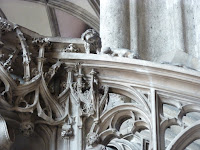
Today was Stephansdom part deux. Before, we had just climbed the stairs to the top of the South Tower, but today we toured the inside. Directly across from the cathedral is the Haas Haus, completed in 1990. As a very modern building, the Haas Haus contrasts very strongly with the gothic/romanesque Stephansdom. Many today feel that the Haas Haus takes away from the Stephansdom and that it attracts more tourists than the cathedral does. I like the juxtaposition of the old cathedral next to the new, modern building. Both are works of art, they just come from two different time periods.The cathedral was built in the mid 12th century in the Romanesque style (an early medieval style), and in the early 14th century the city decided to rebuild it in the Gothic style. Around 1500, the Renaissance was in full swing, and interest in completing the improvements was waning, so the front 2 towers of the cathedral were left in the old Romanesque style. Dr O, our tour guide, gave us an easy way of identifying which sections of the cathedral were gothic or Romanesque, and how old the gothic style is: the simpler the gothic, the earlier it was built. In 1945 the cathedral caught fire, and large sections of the roof caved in. Citizens rushed from their houses with buckets of water to help put out the fire. I think it is amazing that not much was seriously broken. The townspeople went in and took out everything they could, and supported, reinforced, and covered everything else.

(picture on left: border between gothic and romanesque styles on the interior. Gothic style is more patterned, romanesque is simpler)
In the construction of the interior, one name is especially important:Master Anton Pilgrim, a mason from the Czech Republic. He is famous in the cathedral for two items: a pulpit, where sermons were read, and the organ loft. The pulpit is an extremely intricate work, sculpted out of only three stone slabs. The banister consists of wheels with alternating three and four spokes, 3 and 4 representing humanity (the four directions, the four seasons, the four elements, etc) and the divine (the holy Trinity, etc). Also, on a side note, I would like to point out that there are 343 steps in the South Tower. Coincidence? I think not. Frogs (symbols of evil and disease) are carved along the topof the rail, but are prevented from reaching the top by a small dog, the symbol of fidelity (that’s where Fido comes from). Originally, Master P’s organ loft was scoffed at and nobody expected it to stay up. He responded to this by saying he would hold it up himself, and carved his face at the base of the organ loft, and the loft is still structurally sound today.
For me, the main appeal of this church is all the stories, legends, and symbolism it has accumulated over the years. In a chapel on one side there is a Jesus statue with a horsehair beard, which is said to grow and shrink depending on the weather. Across from this is a statue of Mary which is said to cry if Vienna is experiencing hard times. By the entrance are two iron bars mounted on the wall that were used as the standards of measurement. This was used to settle arguments in which one citizen would accuse another of shortchanging him in the marketplace. The defendant would use these iron bars to determine if he was right, and if he was the accused would be escorted to the jail down the street. I can see why the city values this church
Detsches Tagewort: Krieg: Es bedeutet eine grosse Schlacht, in der viele Nationen teilen mit. Auf English bedeutet es 'War.' Und ein Satz mit dem Wort: Niemand wusste, wovon der Krieg stammte, aber es war ihnen klar, dass sie einander töten wollten.



No comments:
Post a Comment